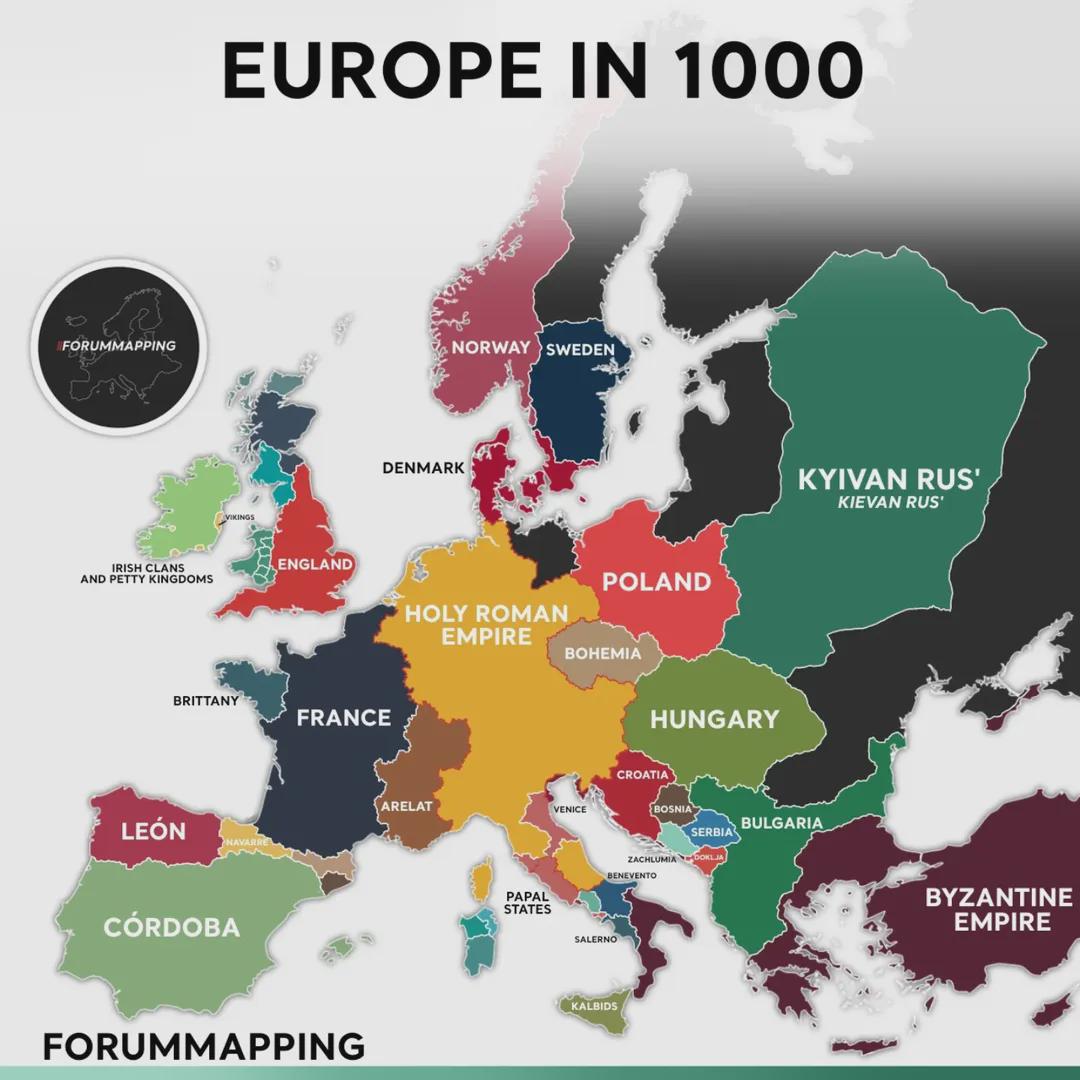Map of Europe in 1000


Alex Cartwright
Senior Cartographer & GIS Specialist
Alex Cartwright is a renowned cartographer and geographic information systems specialist with over 15 years of experience in spatial analysis and data...
Geographic Analysis
What This Map Shows
The map titled "Europe in 1000" provides a fascinating glimpse into the political and cultural landscape of Europe at the turn of the first millennium. It depicts various kingdoms, empires, and territories that defined the continent during this transformative period. From the Byzantine Empire in the east to the Viking territories in the north, this visualization captures the complexities of Europe's borders and societies nearly a thousand years ago.
Interestingly, this era marked a significant transition from the early medieval period to the more established structures of governance and culture that would follow. It was a time when tribal affiliations began to shift towards more centralized kingdoms, setting the stage for the nation-states we recognize today.
Deep Dive into Political Landscape
The political landscape of Europe in the year 1000 was a patchwork of emerging kingdoms and established empires. The Holy Roman Empire, for instance, was a significant force in Central Europe, encompassing a wide range of territories that included present-day Germany, Austria, and parts of Italy. Its influence spread through the promotion of Christianity and the feudal system, which structured society around land ownership and vassalage.
In the north, the Scandinavian countries were not yet unified, but the Viking presence was prominent. The Norsemen had established settlements as far as Iceland and Greenland, and their expeditions were crucial in shaping trade routes and cultural exchanges across Europe. Have you ever wondered how Viking culture influenced the regions they reached? Their explorations not only expanded their own territories but also introduced new ideas and goods to the lands they encountered.
To the west, the Kingdom of England was emerging from a series of invasions and conflicts, including the Norman and Danish incursions. By 1000, England was starting to consolidate its power under a more centralized monarchy, paving the way for the future unification of its various kingdoms. On the other hand, the Kingdom of France was also in a state of flux, with powerful dukes asserting control over vast regions while the king struggled to maintain authority over the entire realm.
In southern Europe, the Byzantine Empire represented the remnants of the Roman Empire, a significant player in global trade and culture. However, its territories were under constant threat from both internal strife and external pressures, notably from the Islamic Caliphates that were expanding into the Mediterranean.
Regional Analysis
When we break down the map into regions, several interesting trends emerge. In the British Isles, the Celtic kingdoms were characterized by tribal governance structures, with frequent conflicts over territory and resources. The Danelaw, established by the Vikings in England, exemplified the blend of cultures and the shifting power dynamics of the time.
Moving to Central Europe, the Holy Roman Empire was a conglomerate of various duchies and principalities, each with its own local rulers. This decentralized nature often led to conflicts among nobles, showcasing a lack of unity that would later be a driving factor for reform and power consolidation in the region.
In Southern Europe, the Byzantine influence was profound. The empire's control over trade routes in the eastern Mediterranean facilitated cultural exchanges that would impact the Renaissance centuries later. The Islamic Caliphates, on the other hand, were making significant inroads into Spain and Sicily, creating rich cultural mosaics that blended Christian and Islamic traditions.
Significance and Impact
The political divisions and cultural interactions depicted in the "Europe in 1000" map have long-lasting implications for the continent's history. Understanding this period helps us trace the foundations of modern European nations and their identities.
Moreover, the interactions between different cultures during this time laid the groundwork for the exchanges that would flourish in the Middle Ages, impacting trade, religion, and even the arts. For instance, the blend of Islamic and Christian cultures in Spain would later fuel the European Renaissance. As we look to the future, recognizing the historical context of these regions helps us understand contemporary political and cultural dynamics within Europe.
Interestingly, many of the territorial disputes and cultural identities we see today can be traced back to these early medieval foundations. The legacy of feudalism, the spread of Christianity, and the interactions among diverse cultures are still relevant in discussions about European unity and identity today. As we study this map, it becomes clear that the past continues to shape our present in profound ways.
Visualization Details
- Published
- October 19, 2025
- Views
- 38
Comments
Loading comments...